James Franco announces a new exhibition of art entitled Fat Squirrel
2015-02-09
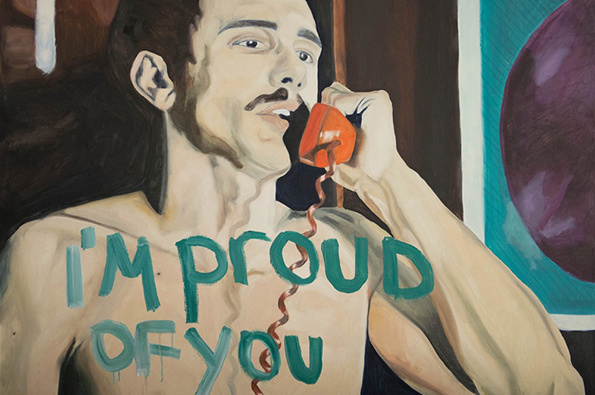 I’m Proud of You
I’m Proud of You
Renaissance man and Hollywood maverick, James Franco, has gone from A-List actor to director, grad student, teacher, poet, musician, sex icon and now artist. A performer who can play both stoner and rogue with equal conviction, the 36-year-old is a man of many masks. Returning to school in 2006 as an English major at UCLA, the erudite actor takes his studies very seriously – he even missed the 2011 Academy Award nominee announcements (despite being a favourite) in order to attend classes. Now weeks away from completing a PhD in English literature, it’s clear that this Hollywood intellectual can’t get enough.
As he prepares to launch his latest series of paintings, in an exhibition titled Fat Squirrel, we meet our December 2013 cover star at the Siegfried Contemporary Private Showroom in West London to find out more. Dressed in a red lumberjack shirt, faded jeans and leather jacket, the actor sports a freshly shaved head and his trademark moustache. As he reclines on a chaise lounge, he knocks back his espresso (despite playing stoner Saul Silver in Pineapple Express (2008), Franco doesn’t drink or smoke) we discuss film, going back to school and the trials and tribulations of social media.
What inspired this particular exhibition?
James Franco: I did a show in New York earlier this year and although I didn’t read any press, I know it was really bad. It felt like it was a perfect storm – “Oh, an actor doing art”. I was referencing one of the gods of the New York art world, Cindy Sherman, in this mega gallery and it was just … well everything! So I thought I have all this other work that doesn’t reference any other art – that’s just the simple act of painting. This exhibition is all paintings, which is something I haven’t done since I was really young – I’ve been painting since I was in high school.
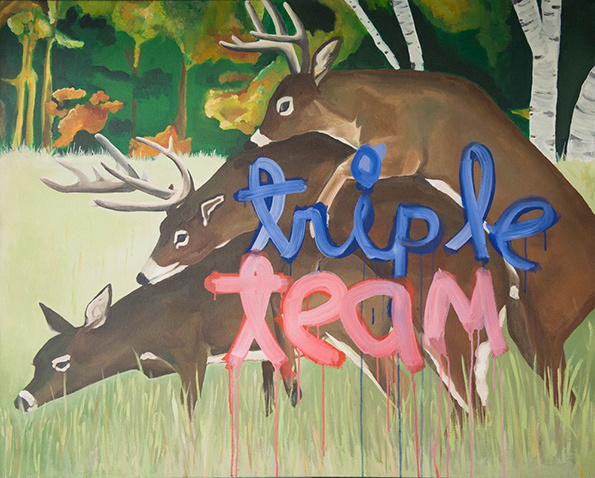 Triple Team
Triple Team
The paintings are almost childlike – what would you say this represents?
James Franco: I think one of my huge themes is childhood and coming of age because it’s such an important and formative period. Whether it’s my childhood or teens, those are the periods that I always return to in my writing or in my art. At least for me. It’s when I started getting interested in all of the things that I’m in interested in now. It’s where I can see the seeds for everything that made me or everything that I rebelled against. It’s that time when everything starts to come together. By doing these paintings – like you say, in a childish way – it’s a way of referencing that time.
And the animals – would you call yourself an animal lover?
James Franco: Yeah but not in that way [laughs]. If I’d done these as portraits of people, it immediately just becomes about who the people are but if it’s an animal, you can get away with it. The subject matter is such that it’s harder to criticise because animals are so innocent.
Can you talk me through the three separate series to this exhibition?
James Franco: All these paintings were generated in different ways. Some of them are done completely by my hand and some are partly done by a pet painter – somebody that makes money by painting pets – that I commissioned and I painted on top of. Some are collages of children’s books and images that I’ve taken and painted on.
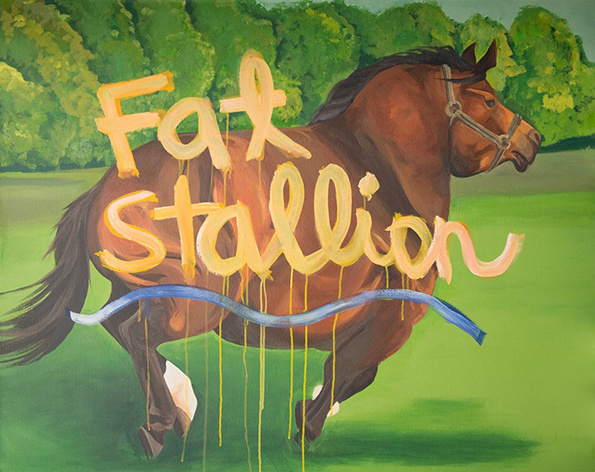 Fat Stallion
Fat Stallion
How would you say your experience in film has influenced your artwork?
James Franco: My art comes out of the way I’m used to working in film. Mainstream filmmaking is a very collaborative process. There are so many different departments, and people doing different things. I’ve done lots of collaborations with artists in the art world. For my show at MOCA called Rebel Without A Cause I worked with Paul McCarthy, Ed Ruscha, Douglas Gordon, Aaron Young and Terry Richardson, and I acted in Ryan Trecartin’s films.
There was something different about collaborating with artists than the kind of collaborations that happen on a film set. Maybe that’s because a movie has different roles that have already been worked out. The unions have battled it out for certain kinds of credit; the writer gets this credit to do this, but the rewriter doesn’t get the same credit. In film, all of that has been worked out already, whereas in the art world, it’s not worked out in the same way.
But now you’re doing your own thing with this exhibition – how does that feel?
James Franco: I’d done all these things and as much as I’d loved all of it, I just felt like there was still something weird. I said to myself “Look you’ve done these collaborations. It’s helped you feel safe coming into the art world.” When you collaborate with someone like Paul McCarthy, in my mind it’s sort of like, “Oh yeah, you’ll protect me!” Even though it doesn’t really work out that way. After a while, I thought, “It’s time you put out your own stuff and stop worrying about criticism, or people viewing you as an actor moonlighting in the art world.”
I went to art school. I put in as much time as anyone, so just go and own it. But that being said, I’m still used to a certain level of collaboration, it’s just the way I love to work. So even though on one level, the collaborations in these paintings are much less apparent than in other work that I do, I still view them as collaborations or hybrids or collages.
How did you find going back to school and revisiting that rite of passage?
James Franco: There was something that I loved about going back to school. In fact I was just talking to this young art collector about it downstairs. I was remembering that I had this pretty nice collection of art, but when I went back to school it meant that I wasn’t going to be able to act in as many movies so my accountant at the time had me sell all my art!
School must have been very important to you?
James Franco: Yeah, school was important to me. I also knew that if I was going to go to school and really make it a priority then this was my time. I had two or three years where I could just go and focus on what I was going to focus on because I’d carved out that time. Most of my fellow students were going to school and they had full time jobs, but I was fortunate enough that I didn’t have to have a job as I already had a career. Instead of a job, in addition to school, I could just go to more than one graduate school, so I just went to a bunch of schools. It was my time to engage in a serious way with all the other things that I was interested in.
So have you already embarked on your PhD?
James Franco: Yeah I’ve been working on it for a while – it takes a while! It’s in English literature. I’m done with almost everything except my dissertation.
Would you say you’re trying to steer away from your film career?
James Franco: One of the keys to my career or how I’ve been able to continue to do all of the things I’ve wanted to do is balance. I think I’m very fortunate in that the movies that are commercially successful, like the ones I do with Seth [Rogan], are in fact movies that I also love. They’re often whacky comedies and are pretty important movies in a kind of satirical way. And that work enables me to do other kinds of work. It affords me time.
Would you say that’s almost secondary to your own personal creative projects?
James Franco: You’d think that but I guess what I’m trying to say is all of that work gives me a certain kind of commercial cache and stature in the business that I can then spend in these other areas. But even if all I had were those movies, I should count myself blessed and be grateful.
Does your experience as a celebrity inform your work?
James Franco: Yeah, but not in a gratuitous way. Almost in a more universal way. The way that we live now, the way that people function on social media is moving closer and closer to the way that celebrities live already. Now your life is on view, your life is inspected. People can see what you’re doing at all times. That’s where everybody is moving towards, so if I do work that’s based on my own kind of experiences in the public eye it’s actually more universally applicable than it might seem. I’m not just commenting on being a celebrity, it’s actually how we all live now.
You once said something about “attention being power” in this day and age…
James Franco: On one level it’s still silly to me. If you go on my Instagram, you can see that I don’t take it that seriously. But on the other hand it is serious. Attention is one of our main currencies nowadays. When you have that number of followers – in the millions that I have – companies who want to do business with me take that very seriously. I just did a commercial for Verizon and part of the deal was that I had to post a certain number of things on my social media. So this silly thing Instagram that I do, that I just have fun with, is actually now a bargaining tool and is something very concrete.
Would you say you find it oppressive or liberating constantly having to maintain this online presence?
James Franco: Social media is a funny thing – it’s the same old game of balancing what people want with what you want to express. I put out more of what I want to express and what I want to talk about. I would have more followers if I posted handsome pictures of myself once every three or four days. I would probably have twice the amount of followers, but I wouldn’t want an account like that – it would be boring to me. I’ll go up against the line but then you’re like “Oh, that’s over the line. Okay don’t go that far anymore.” If you do a lot things, you also learn this is the sphere where I can do X. In this Disney movie Oz, don’t try to push anything. This is for family entertainment. Whereas over here, in this gallery, you can go further, you can do whatever. You learn which context can hold which subject.
You’ve dabbled in a bit of everything, but what do you think you are happiest doing?
James Franco: I don’t know which one’s more important. I think the way that my career and identity has developed, they are equally important. What you’ll find on any kind of creative graduate programme is that they’re teaching you to find your voice and your subject and your thing. What you can say and how you can say it is unique to you. My “thing” is that I have one foot in Hollywood and now I have another foot in all these other worlds, and so if I bring those two things together – that’s my unique position. There are lots of artists who use cinema as subject or inspiration but not many of those artists also have a career in mainstream cinema.
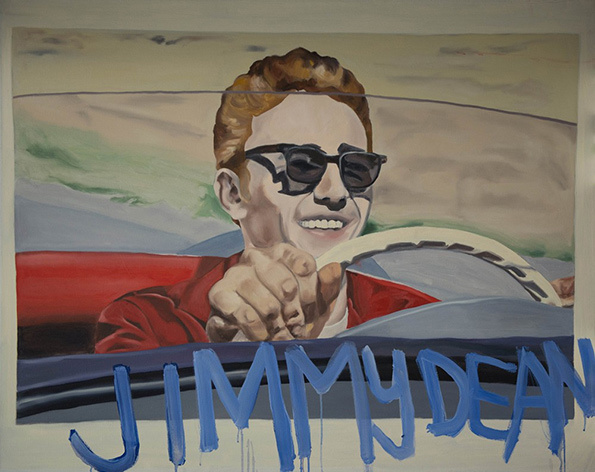 Jimmy Dean
Jimmy Dean
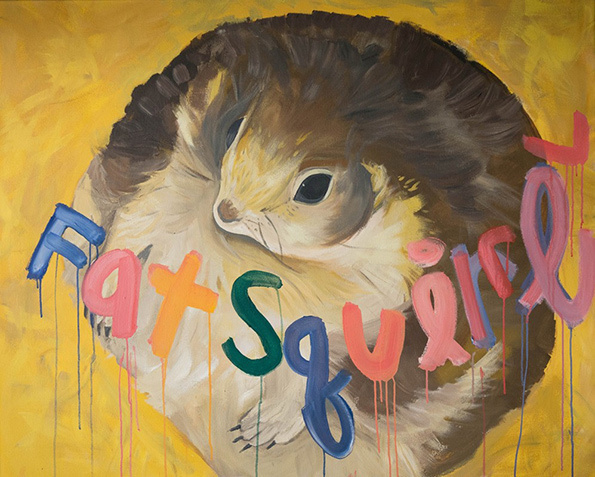 Fat Squirrel
Fat Squirrel
 Gus
Gus
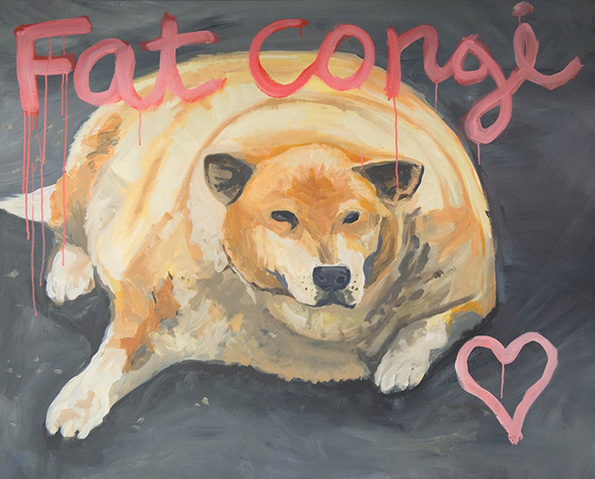 Fat Corgi
Fat Corgi
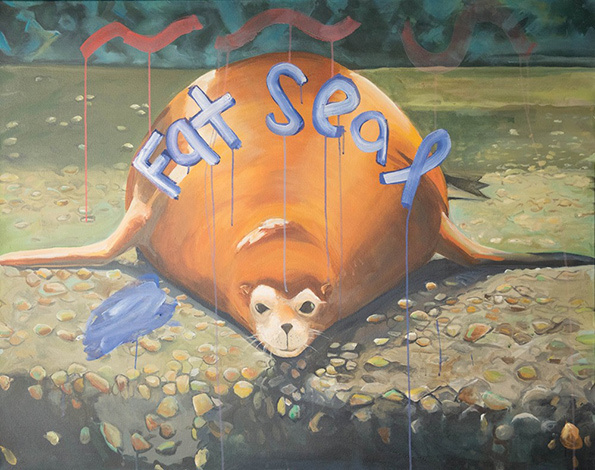 Fat Seal
Fat Seal
Source http://www.dazeddigital.com/artsandculture/article/22720/1/james-franco-s-animal-kingdom